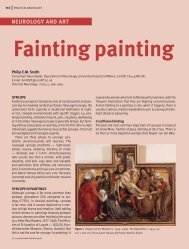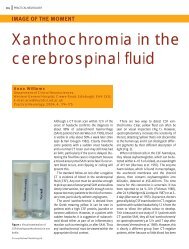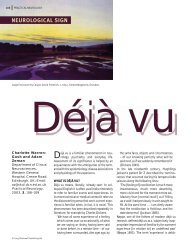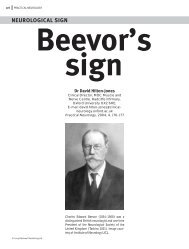The carotid bruit - Practical Neurology
The carotid bruit - Practical Neurology
The carotid bruit - Practical Neurology
You also want an ePaper? Increase the reach of your titles
YUMPU automatically turns print PDFs into web optimized ePapers that Google loves.
Table 2 <strong>The</strong> source of neck <strong>bruit</strong>s<br />
Carotid bifurcation arterial <strong>bruit</strong><br />
Internal <strong>carotid</strong> artery stenosis<br />
External <strong>carotid</strong> artery stenosis<br />
Supraclavicular arterial <strong>bruit</strong><br />
Subclavian artery stenosis<br />
Vertebral artery origin stenosis<br />
Can be normal in young adults<br />
Diffuse neck <strong>bruit</strong><br />
Thyrotoxicosis<br />
Hyperdynamic circulation (pregnancy, anaemia, fever, haemodialysis)<br />
Transmitted <strong>bruit</strong> from the heart and great vessels<br />
Aortic valve stenosis<br />
Aortic arch atheroma<br />
Mitral valve regurgitation<br />
Patent ductus arteriosous<br />
Coarctation of the aorta<br />
<strong>bruit</strong> will be of short duration and heard just in<br />
mid-systole. As the degree of stenosis increases,<br />
the <strong>bruit</strong> is likely to become more audible and<br />
longer, expanding to be pan-systolic. Soft,<br />
long duration, high frequency <strong>bruit</strong>s represent<br />
haemodynamically-severe stenosis with a large<br />
pressure gradient throughout the cardiac cycle.<br />
<strong>The</strong> intensity of the <strong>bruit</strong> correlates with the degree<br />
of stenosis to some extent. A harsher <strong>bruit</strong><br />
implies greater stenosis, but remember that<br />
stenoses of more than 85% may be associated<br />
with low fl ow through the <strong>carotid</strong> artery, and<br />
hence no audible <strong>bruit</strong> at all.<br />
SENSITIVITY AND SPECIFICITY OF<br />
CAROTID BRUITS<br />
How reliable a sign is a <strong>carotid</strong> <strong>bruit</strong>? In symptomatic<br />
patients, Ziegler and colleagues found a<br />
sensitivity of only 0.29 and a specifi city of 0.61 for<br />
detecting stenosis greater than 50% (Ziegler et al.<br />
1971). <strong>The</strong> collaborators of the North American<br />
Symptomatic Carotid Endarterectomy Trial<br />
(NASCET) found that a focal <strong>carotid</strong> <strong>bruit</strong> had<br />
a sensitivity of 63% and a specifi city of 61% for<br />
high-grade stenosis (Sauve et al. 1994). In such<br />
patients when <strong>bruit</strong>s were absent, this only lowered<br />
the probability for high-grade stenosis from<br />
a pretest value of 52% to a post test probability<br />
of 40% (Sauve et al. 1994). When combined with<br />
four other clinical characteristics (infarction on<br />
CT brain scan, a <strong>carotid</strong> ultrasound scan suggesting<br />
more than 90% stenosis, a transient ischaemic<br />
attack rather than a minor stroke as a qualifying<br />
event, and a retinal rather than a hemispheric<br />
qualifying event), the predicted probabilities of<br />
high-grade stenosis ranged from a low of 18%<br />
(when none of the features was present) to a<br />
high of 94% (when all the features were present).<br />
Hankey and Warlow reported the most favourable<br />
of results, the presence of a <strong>bruit</strong> in patients<br />
with a symptomatic internal <strong>carotid</strong> artery had a<br />
sensitivity of 76% and a specifi city of 76% for the<br />
detection of <strong>carotid</strong> stenosis (defi ed as diameter<br />
stenosis of the ICA of 75–99%, as measured by<br />
the ECST method) (Hankey & Warlow 1990).<br />
So, in the right kind of patients, <strong>carotid</strong> <strong>bruit</strong>s<br />
are quite good (but not perfect) at identifying<br />
patients with signifi cant stenosis. A good going<br />
<strong>bruit</strong> is also a reasonably robust clinical sign.<br />
Among 55 patients examined independently by<br />
two neurologists (both of whom had normal<br />
audiograms), the agreement beyond chance for<br />
the presence of a <strong>bruit</strong> was good, with a kappa<br />
statistic of 0.67 (Chambers & Norris 1985).<br />
BRUITS IN SYMPTOMATIC<br />
PATIENTS WITH SUSPECTED TIA<br />
OR ISCHAEMIC STROKE<br />
In general, the presence or absence of a <strong>bruit</strong> is<br />
clinically most useful in symptomatic people.<br />
<strong>The</strong> most relevant intervention is <strong>carotid</strong> endarterectomy<br />
for patients with severe, recently<br />
symptomatic <strong>carotid</strong> stenosis. In the majority<br />
of such patients the benefi ts of surgery outweigh<br />
the risks (Cina et al. 2001). In our neurovascular<br />
clinic, if we have a patient with a recent <strong>carotid</strong><br />
territory nondisabling ischaemic stroke or TIA,<br />
who is fi t for surgery, and is prepared to consider<br />
having an endarterectomy, we aim to perform<br />
a <strong>carotid</strong> Doppler ultrasound on the same day,<br />
whether or not the patient has a <strong>bruit</strong>. In other<br />
words, the presence of a <strong>bruit</strong> is noteworthy, but<br />
AUGUST 2002 223<br />
© 2002 Blackwell Science Ltd







